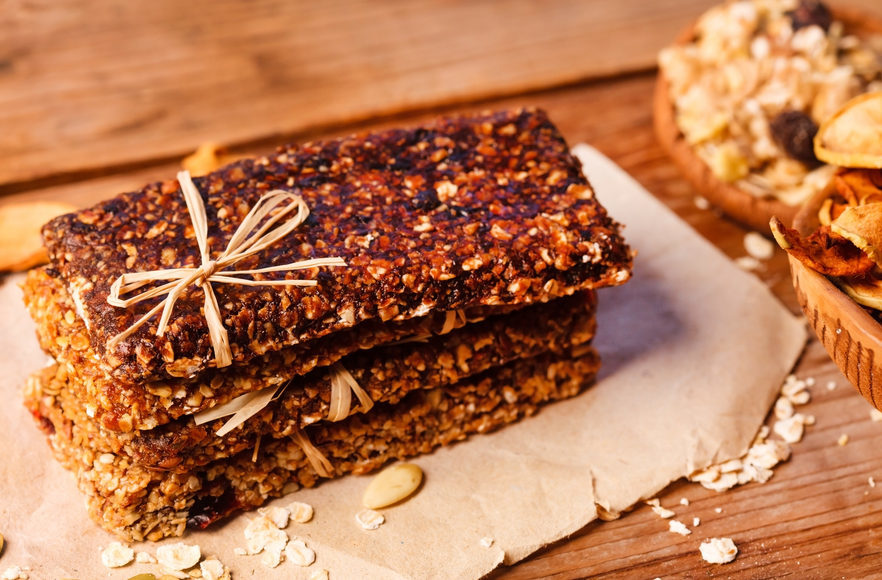These apple butter crunch bars are healthy, delicious, and easy to bake – and they make the perfect holiday treats for your horse!
Everybody loves special holiday treats, but they’re not always very healthy. Treat your horses well this season with these wholesome homemade apple butter crunch treats!
Ingredients
- 6 cups quick oat flakes
- 1/2 cup chia seeds
- 1 cup apple butter (no added sugar)
- 1/3 cup unsulphured blackstrap molasses
- 1 cup grated carrot
- 1 teaspoon Saigon cinnamon
Instructions
- Choose organic ingredients whenever possible.
- Preheat your oven to 350°F (180°C). Convection is great if you have that option.
- Line a large cookie sheet with parchment paper, but don’t trim the paper until after your mix has been pressed into the sheet.
- Combine all ingredients in a large bowl. This can easily be done by hand or in a mixer or blender.
- Turn mix onto the cookie sheet, spreading it to make sure it reaches all the corners and is as even as possible.
- Trim the excess parchment paper, press down the mix with the back of a big spoon, and lightly score with a sharp knife. This recipe can also be rolled out and cut into any shape you like. You can even make truffles.
- Pop the cookie sheet into the preheated oven and bake for 30 minutes, for a “chewy” treat or “truffles.”
- For more “crunch,” turn the oven down to 175°F (80°C), and bake for a further 30 minutes.
- Allow to cool completely before storing in a jar or Ziploc bag. Use a decorative box for gift-giving.
About the ingredients
Chia
Chia is considered one of the world’s healthiest foods. It has a long, storied history, going all the way back to 3500 BC. Chia seeds are a rich source of B vitamins, calcium, copper, iron, magnesium, phosphorus, potassium, protein and zinc, and they are packed with antioxidants. Chia is a valuable source of alpha-linolenic acid (ALA), a plant-based form of Omega 3. They are gluten-free and a great alternative to flax seeds. These amazing tiny seeds help support healthy skin, coat and hooves.
Oats
Oats are a strength-giving cereal. They contain 20 unique polyphenols called avenanthramides, which have potent antioxidant, anti-inflammatory, and even anti-itching properties. Scandinavian researchers found that adding oats to a gluten-free diet may enhance the nutritional values of the diet’s vitamins and minerals, as well as its antioxidant levels, including bilirubin, which helps in the elimination of free radicals and protects the brain from oxidative damage.
Oats support the gastrointestinal system by helping to remove toxins from the body. Research reported by the American Institute for Cancer Research showed that whole grains, like oats, contain many phytonutrients whose healing and preventive properties have gone unrecognized, simply because research methods have overlooked them. Incidentally, oats are also a very good source of selenium, which is a co-factor to the antioxidant glutathione peroxidase.
Red apples
Red apples are a rich source of antioxidants. They are heart smart, and studies have demonstrated that they help inhibit the growth of cancer cells. Red apples contain the phytochemicals, lycopene and anthocyanins, along with lots of vitamin C, calcium, chlorine, fluorine, iron, magnesium, phosphorus, potassium, silicon and sulphur. Red Delicious, Northern Spy and Ida Red apples have more potent disease-fighting antioxidants than other apples. This is reflected in their higher levels of polyphenol activity.
Carrots
One of the kings of the vegetable patch is the carrot. Its history takes us back thousands of years, to Central Asia and the Middle East. Roman writings dating back to the third century make reference to this nutrient-dense root vegetable that is related to fennel, parsnips, cumin and dill.
There are over 100 varieties of carrot, from the deepest purple and white, to the brilliant orange we are most accustomed to seeing, and each is a storehouse of nutrient power. Carrots contain pro-vitamin A, beta-carotene, vitamins B, C, D, E and K, and riboflavin, niacin, calcium, potassium, phosphorus, sodium, iron, magnesium, manganese, sulphur, copper and iodine.
Carrots support the immune system, aid digestion, and are also recognized as a glandular tonic, skin cleanser and eye conditioner.
Cinnamon
Cinnamon’s history can be traced all the way back to the ancient Egyptians, and ancient Chinese herbal references cite its use as early as 2700 BC, when it was recommended for the treatment of nausea, fever and diarrhea. Cinnamon was also added to food to prevent spoilage. During the Bubonic Plague, sponges soaked in cinnamon and cloves were put in sickrooms. Native American Indians used cinnamon for diarrhea, chills and even to freshen breath.
Today it is used in much the same way, treating a variety of gastrointestinal problems, including nausea and flatulence. The oil found in cinnamon has antifungal and antibacterial properties. It is also a carminative and used as a digestive tonic when prepared as a tea.
Blackstrap molasses
Blackstrap molasses is a valuable source of vitamins and minerals, including calcium, copper, iron, magnesium, manganese, phosphorus, potassium, selenium, zinc and vitamin B6. It is also a source of chromium, which plays a role in insulin-signaling pathways, helping to balance blood glucose levels. Blackstrap molasses contains lactic acid, helping to promote healthy skin and wound healing.








